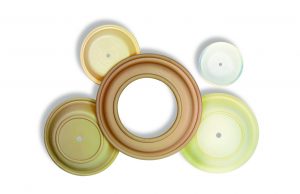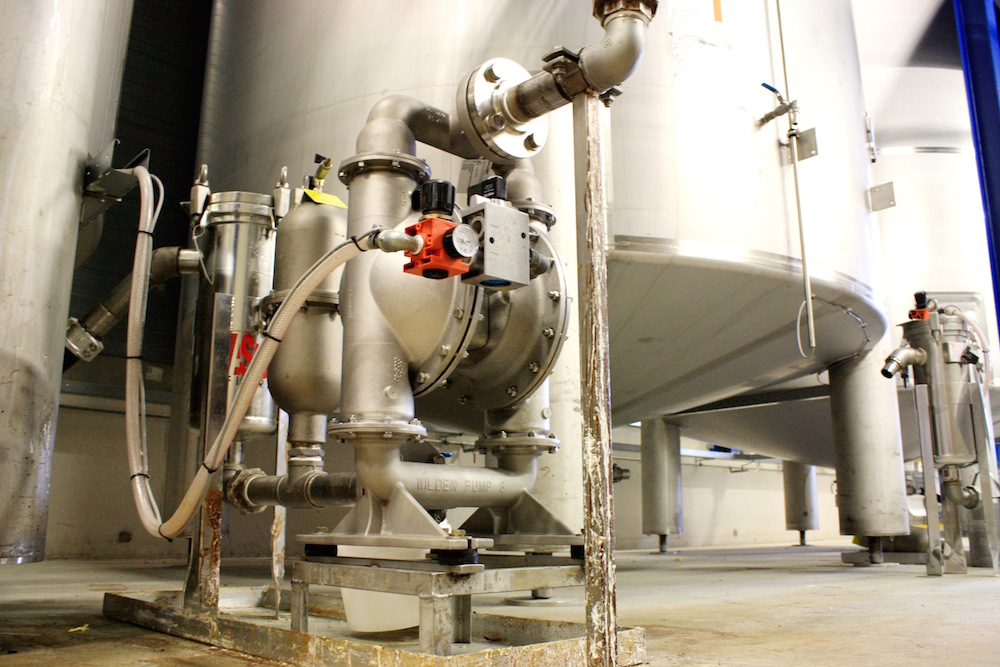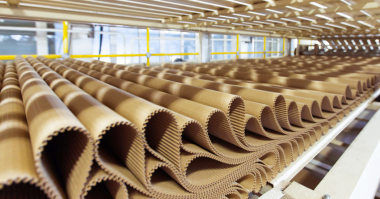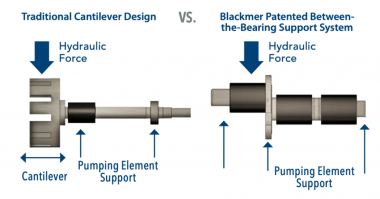Selection of the right diaphragm for an air-operated double-diaphragm (AODD) pump is a critical consideration for safety, efficiency and trouble-free operations. A number of factors must be taken into account when choosing the proper diaphragm that will be suitable for a specific application. Previous experience is always a very helpful guide, but new applications will often require research and outside advice to determine the appropriate diaphragm that will meet specific application requirements and parameters.
In selecting a diaphragm, there are seven primary factors to consider:
- Chemical resistance – Material compatibility with the fluid being pumped. The spectrum of fluids pumped can range from water to aggressive acids and caustics. Each diaphragm material has been tested to measure its compatibility against many chemicals. The operator should evaluate the pumped fluid against published chemical compatibility guides.
- Temperature ranges – Capability to remain flexible in low temperatures and not deteriorate in high temperatures. Temperature is a very critical factor, and the working range available in diaphragm materials varies greatly. The type of fluid can also affect the working temperature range of the material.
- Abrasion resistance – Ability to withstand wear and friction from contact with solids and particles in the fluid being pumped. Diaphragms are available to handle fluids ranging from clear to heavy slurries to dry bulk pumping.
- Sanitary standards – Requirements that the diaphragm comply with hygienic or sanitary standards. Applications in the food and beverage industry must utilize diaphragms that comply with U.S. Food and Drug Administration (FDA) 21 CFR 177 standards. Diaphragms used in the pharmaceutical industry must comply with United States Pharmacopeia Convention (USP) Class VI standards.
- Inlet condition (flooded suction and suction lift) – Capacity to pump fluid from one location to another. For different pumping configurations and conditions, certain diaphragm materials are more efficient and longer lasting than others. Outside advice from an expert such as a Wilden distributor can assist in determining the optimum material for specific applications.
- Flex life – Expected longevity of the diaphragm before requiring replacement. Achieving maximum mean time between repairs (MTBR) is a key goal in selecting a diaphragm. However, some materials have inherently shorter flex lives than others even under ideal conditions.
- Cost – Total cost of ownership determined by multiple factors such as initial price, rated flex life for the application and costs of downtime and diaphragm replacement labor. Because of the many variables involved, advice from an outside expert such as a Wilden distributor can greatly assist in selecting the best performing, most cost-effective option for individual applications.
Over the years, a number of materials have been tested extensively for use in diaphragms in AODD pumps. These materials can be grouped into three primary families: rubber, TPE (thermoplastic elastomer) and PTFE (Polytetrafluoroethylene or Teflon®). Each family and the materials within each family offer properties and attributes that make them suitable for different applications.
Rubber Diaphragms
Rubber diaphragms are compression molded of synthetic rubber with a nylon fabric mesh positioned within the rubber to improve the diaphragm’s flexing characteristics. The following are the rubber diaphragm materials available:
- Neoprene is an exceptional general-purpose, low-cost diaphragm. Perfect for nonaggressive chemical applications such as water-based slurries, well water or seawater, it provides good flex life and abrasion resistance.
- Buna-N provides excellent performance in applications involving petroleum/oil-based fluids such as leaded gasoline, fuel oils, kerosene, turpentine and motor oils. In wide use throughout the fuel processing industry, Buna-N is also referred to as nitrile and provides moderate flex life and moderate abrasion resistance. For food and beverage applications, versions are available that comply with FDA 21 CFR 177 standards.
- EPDM is an excellent material for extremely cold temperatures and is an economical alternative when pumping dilute acids or caustics. EPDM diaphragms are in use in the manufacturing, food, pharmaceutical and paint/ coating industries. The material exhibits good flex life and moderate abrasion resistance, and it is available in versions that comply with FDA 21 CFR 177 standards. EPDM is also a good choice where statically dissipative materials are required.
- Viton® is excellent for extremely hot temperatures and provides exceptional performance with aggressive fluids such as aromatic/chlorinated hydrocarbons and strong, aggressive acids. Viton is often the only diaphragm material suitable for applications where harsh chemicals are used because of its high temperature limit and chemical resiliency. It provides moderate flex life and moderate abrasion resistance.
Thermoplastic Elastomer (TPE) Diaphragms
TPE diaphragms are manufactured by injection molding. As a result of their dimensional stability and tensile strength, TPE diaphragms do not need fabric reinforcement. Following are the available types of TPE diaphragms:
- Polyurethane is an outstanding general-purpose diaphragm for nonaggressive chemical applications such as water, wastewater and seawater. It provides excellent flex life, abrasion resistance and durability at an economical price.
- Wil-Flex™ provides a low-cost alternative to PTFE with a cost comparable to neoprene. Made of Santoprene™, Wil-Flex is ideal for use with acidic and caustic fluids such as sodium hydroxide, sulfuric or hydrochloric acids. Exhibiting excellent flex life, abrasion resistance, temperature range and durability, it is widely used in the chemical process, food, pharmaceutical and wastewater industries. Versions of Wil-Flex are available that comply with FDA 21 CFR 177 standards for food and beverage applications.
- Saniflex™ is an excellent material for food processing applications. Made of Hytrel®, it exhibits good flex life and excellent abrasion resistance. Hytrel also offers superior sealing or seal energizing due to its low compression set characteristics. Saniflex versions are available that comply with FDA 21 CFR 177 standards.
- Geolast® exhibits enhanced oil-resistance and low oil swell making it ideal for petroleum industry applications. Equivalent to nitrile (Buna-N), Geolast provides moderate flex life and good abrasion resistance over a wide temperature range at a lower cost than fabric-reinforced Buna-N.
Polytetrafluoroethylene (PTFE) Diaphragms
Because it is one of the most chemically inert compounds available, PTFE can be used with an extremely wide range of fluids. Also known as Teflon®, PTFE is excellent for highly aggressive fluids such as aromatic or chlorinated hydrocarbons, acids, caustics, ketones and acetates. Its  properties provide excellent flex life and moderate abrasion resistance. In addition, PTFE complies with FDA 21 CFR 177 and USP Class VI standards for food, beverage and pharmaceutical applications. Because PTFE is non-elastic, a backup diaphragm of a different material must be used to provide flexibility and memory. Material options for backup diaphragms are Neoprene, Saniflex and high temperature Buna-N.
properties provide excellent flex life and moderate abrasion resistance. In addition, PTFE complies with FDA 21 CFR 177 and USP Class VI standards for food, beverage and pharmaceutical applications. Because PTFE is non-elastic, a backup diaphragm of a different material must be used to provide flexibility and memory. Material options for backup diaphragms are Neoprene, Saniflex and high temperature Buna-N.
Rating and Comparing Diaphragm Materials
Using extensive material testing and field data, Wilden®, Grand Terrace, CA, USA, compiled a Diaphragm Selection Guide that compares and rates the flex life, abrasion resistance, chemical resistance, temperature limits and relative cost of each material type. It is important to note that this chart should be used only as a guideline and in conjunction with thorough additional research and expert advice to determine the suitability of diaphragm materials for individual applications because one factor can affect another.
When using the chart, always strive for an “A” or “B” rating and keep the application’s maximum fluid temperature as close to the center of the “Operating Temperature Limits” as possible. The selection of “C” -rated materials is generally not recommended but may be necessary in rare exceptions where fluids are highly specialized or processed under extreme conditions. For some applications, two different materials may be suitable with cost being the final deciding factor.
Other factors to consider in selecting the right diaphragm include the hardware configuration of the pump, type and frequency of cleaning fluids, pump operation (intermittent or continuous), and how often diaphragms are being replaced. On average, diaphragms that need to be replaced more often than every three months warrant further evaluation as to the right fit for the application.
Conclusion
Whether pumping water, aggressive acids, food products or solid-laden slurries, there is a Wilden diaphragm for every application. The challenge can often be selection of the optimum diaphragm that will assure safe, efficient, cost effective and trouble-free operations.
Determining the correct diaphragm requires carefully identifying and factoring all process and application parameters into the analysis. Because one selection factor can offset another, expert advice should be obtained in determining compatibility based on all factors. A valuable resource to assist with diaphragm selection is the network of Wilden distributors who have extensive training in AODD pump technology and applications. A Wilden distributor locator, and additional information on diaphragms, chemical compatibility, elastomers and AODD pump technology can be found on Wilden’s new diaphragm-specific website at www.WildenDiaphragms.com.
About the Author:
Rob Jack is a Development Engineer IV for Wilden® and PSG® based out of Grand Terrace, CA, USA. Wilden is a leading manufacturer of air-operated double-diaphragm (AODD) pumps. He can be reached at +1 909-422-1784 or Rob.Jack@psgdover.com. For more information, please go to www.wildenpump.com. Wilden is part of PSG®, a Dover Company, Oakbrook Terrace, IL, USA. PSG is comprised of several leading pump brands, including Abaque®, Almatec®, Blackmer®, Ebsray®, GriswoldÔ, Maag Industrial Pumps, Mouvex®, NeptuneÔ, QuattroflowÔ, RedScrew™ and Wilden®. You can find more information on PSG at www.psgdover.com.
Hytrel®, Viton® and Teflon® are registered trademarks of DuPont™ Company.
Geolast® and Santoprene® are registered trademarks of ExxonMobil.
Saniflex™ and Wil-Flex™ are registered trademarks of Wilden®.






Thanks for sharing this information with us, I learn about how to select diaphragms for aodd pumps from your blog and that helped me to purchase Pumps